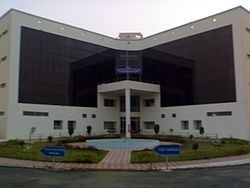Reporting mark GNT Track gauge Broad Length 629.75 km (391.31 mi) Predecessor Southern Railway zone | Dates of operation 1 April 2003– Previous gauge Metre Date of operation 1 April 2003 | |
 | ||
Guntur Railway Division is one of the six divisions of the South Central Railway zone of Indian Railways. It was created in 1997 for better administration in the respective railway zone and became fully functional on 1 April 2003 with P.N Shukla as its first divisional manager. The headquarters of the Guntur Division are located at Rail Vikas Bhavan, Pattabhipuram, Guntur. The current Divisional Railway Manager is Vijay Sharma, an officer of the IRSE cadre.
Contents
- Guntur railway division special report
- History
- Jurisdiction
- Sections and branch lines
- Categorization of stations
- Performance and earnings
- References
Guntur railway division special report
History
Guntur Division]]
The Krishna Canal-Nandyal (KCC-NDL) stretch was a part of the important East-West coast link that connected Margao in Goa to Masulipatnam in the erstwhile Madras Province of British India. It was originally built to Metre Gauge by the Southern Mahratta Railway (later the Madras and Southern Mahratta Railway-MSMR) during 1889–90. The track passed through the Nallamala Hills and as a result quite a few major engineering works were undertaken in the course of the railroad construction, the most impressive of them being the massive Dorabavi Viaduct and the Bogada Tunnel, both of them about 30 km from Nandyal. This section was converted to Broad Gauge during 1993–95 under Indian Railways' Project Unigauge. The gauge conversion was a difficult task owing to the difficult terrain. The old alignment between Gazulapalli and Diguvametta was abandoned and a new Bogada tunnel, about 1.6 km in length and a new Dorabavi Viaduct located at a much lower altitude were constructed at a huge expense. The railway passes through the historic Cumbum Tank starting from Cumbum railway station for a distance of about 7 km. It is one of the most picturesque valleys in Guntur-Nandyal section of South Central Railway.
The Guntur-Macherla (GNT-MCLA) section was opened in 1930 by the MSMR to serve the backward inner Telangana region. It too was originally metre gauge and was converted to Indian gauge in 1992–93. This section was used for the transport of limestone, quartz &cement, primarily from Piduguralla, popularly known as the Lime City.
The section from Guntur to the coastal town of Repalle was built to the broad gauge by the Madras and Southern Railway in 1916. This line connected to the East Coast main line at Tenali. The section from Tenali to Repalle was owned by Guntur District Board until 1964.
The foundation stone for the 152 km long Bibinagar-Nadikudi rail project that opened an alternative route to Secunderabad from Vijayawada and connected the interior of Telangana to Hyderabad was laid by the then Prime Minister of India, Indira Gandhi on 7 April 1974. The project was finally finished in 1989 and the line commissioned a year later. Two major bridges to span the Krishna River and Musi are located in this section. It is used by many south/east bound trains in a bid to decongest the heavily used Warangal-Vijayawada line.
Jurisdiction
The division is spread over the states of Telangana and Andhra Pradesh and covers the districts of Nalgonda, Guntur, Kurnool and Prakasam. Consisting entirely of Broad Gauge track, it was formed by merging the most far-flung and least productive stretches of Vijayawada, Secunderabad and Guntakal divisions of the South Central Railway. It has 72 major and minor stations.
Sections and branch lines
The division has a broad gauge route of 629.516 km (391.163 mi) and a running track of 660.992 km (410.721 mi).
The sections and branch lines route map breakup is as follows:
Source:
Categorization of stations
The list includes the stations under the jurisdiction of Guntur railway division and classified based on their respective category.
Source:
Performance and earnings
There are total 200 express, passenger and freight trains are operated everyday. In 2003, the Freight earnings were ₹93 crore (US$14 million). A steady increase saw the figure reach ₹272 crore (US$40 million) in 2007-08 before the ongoing worldwide recession brought it down to ₹237 crore (US$35 million) in 2008-09. There was a marginal increase in the number of passengers carried as well as the earnings therefrom. This has now risen substantially to ₹452 crore (US$67 million) in 2013–14. The division's total expenditure in 2012–13 was to the tune of ₹22 crore (US$3.3 million), primarily owing to its track renewal and passenger amenities works. Its Performance Efficiency Index was therefore pegged at 49.56%.
The division was awarded the Signal and Telecommunications Shield of Excellence at the 54th, Railway Week Celebrations of the South Central Railway in April, 2009. The primary commodity transported by the division is cement, clinker, food grains, besides coal and fertilizer. Other commodities include cotton, chillies, limestone, paddy, tobacco and timber waste.
